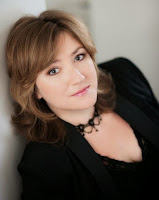 |
| Lucy Parham © Sven Arnstein |
Whilst George Sand has left a comprehensive written record of her relationship with Chopin, the composer's own surviving letters are by no means as revealing and Parham has compiled the narration from a variety of sources, often contemporaries reminiscing about Chopin and about his piano playing.
The narration was roughly chronological, starting with Chopin's arrival in Paris in 1831. Whilst generally West played Chopin and Stevenson played George Sand, both slipped into other characters and provided linking narrations. We heard fascinating descriptions of Chopin's playing from such contemporaries as Sir Charles Halle, as well as the discussion between Liszt about the merits of performing in concerts and why Chopin preferred not to. The first half concluded with Chopin's first meeting with Sand, Liszt's warning to Chopin about her behaviour to her lovers, and Sand's pursuit of Chopin.
The best documented episode in their relationship was their disastrous trip to Majorca, there were problems with accommodation, lack of a piano, with the locals, with an imported piano being impounded, with the weather and Chopin's illness (which may have been cystic fibrosis rather than tuberculosis). We not only have Sand's descriptions but also Chopin's in letters to his sister, which provided a fine counterpoint. Sand and Chopin's later relationship is based heavily on Sand's reminiscences and as she was a novelist, you wonder whether she was re-writing history. We also heard reminiscences from their friend, the painter Delacroix. And finally, the description of Chopin's final moments from Sand's daughter Solange.
 |
| Frederic Chopin by Bisson in 1849 |
Parham's choice of pieces was not historical, she didn't necessary play them in their position in the historical narrative, instead choosing to reflect the emotional tenor of the story, though I think the selection could probably have done with including a little more of Chopin's sturm und drang. Each half finished with a substantial piece, one of the Ballades.
She started with an atmospheric and melancholy performance of the Nocturne in C minor, Op.48 No.1 in which she displayed a nice flexibility and lightness of touch in the right hand combined with a strong bass, plus some spectacular passagework in the octave runs. A crisp account of the Polonaise in A Op.40 no.1 followed, so rhythmic that you felt you could dance to it, but still flexible. The Waltz in C sharp minor Op.64 No.2 was taken at a nice speed, but with a lovely flexible rubato, it was very affecting and certainly not languid. The Etude in A flat Op.25 No.1 was elegant and flowing, with a lovely rippling effect in the right hand, it is not called the Aeolian Harp for nothing. The Mazurka in D Op.33 No.2 was nicely exuberant, but you still felt you could dance to it. The first half finished with the Ballade No. 3 in A flat, Op.47, which started in a deceptively simple manner, with a light and relaxed lilting rhythm, but then Parham developed some stunning power, though the performance perhaps lacked the edge of danger which I think the work needs.
 |
| George Sand |
It has to be admitted that Middle Temple Hall is not quite ideal for spoken word, as at any given time the actors were facing only three quarters of their audience, but Stevenson and West were richly dramatic in the way they evoked the various personalities and characters. They were very admirable in the way that they slipped in and out of different characters. Whilst looking nothing like George Sand, Stevenson evoked something of her intelligence and fascination, and West was brilliant as the mercurial (and temperamental) Chopin.
Starting on 19 January 2014, Lucy Parham has a series of Sunday matinees at St. John's Smith Square in which she will be performing all four of her composer programmes, on Chopin, Liszt, Debussy and Robert and Clara Schumann.
Elsewhere on this blog:
- Jacques Imbrailo and Alisdair Hogarth at the Wigmore Hall
- Gabrieli Sacrae Symphoniae - CD review
- Britten+ Benyounes Quartet and Philip Higham
- Pianist Ivana Gavric in Grieg and Janacek at the Wigmore Hall
- Sony's new Mozart-Da Ponte trilogy
- Beauty and Control - Songs of Home Njabulo Madlala and William Vann - CD review
- Scraping the Bottom - Christopher Gillett - Book review
- Julian Anderson - The Discovery of Heaven - CD review
- Intriguing new play - Sins of the Fathers by Jessica Duchen
- Spectacular cast - Albert Herring at the Barbican
- Opera or Oratorio - Philip Glass's Satyagraha at ENO
- Second view - Mozart's Magic Flute at the London Coliseum
- Britten - Sacred Choral Music - Choir of New College, Oxford - CD review
- Home

No comments:
Post a Comment